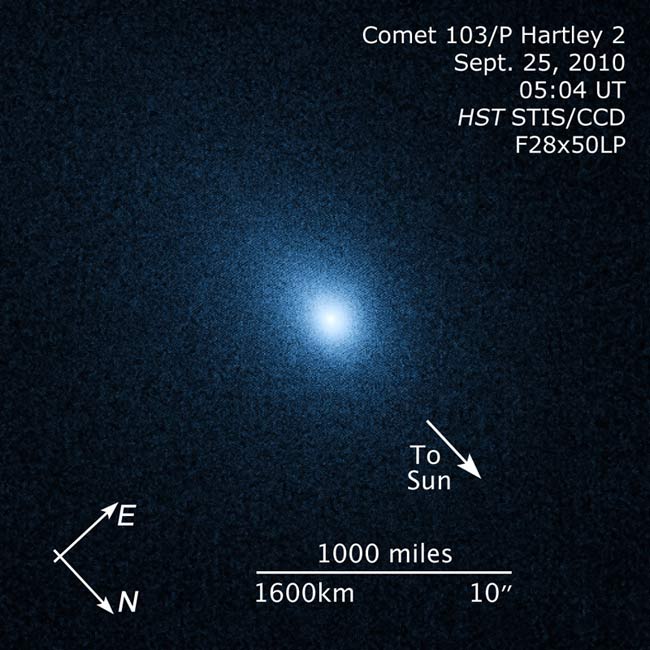
NASA is gearing up for a close encounter with a comet next week.
The space agency's Deep Impact spacecraft has been chasing Comet Hartley 2 for months, and on Nov. 4 the probe will come within a mere 434 miles (698 km) of its icy quarry.
The flyby — which will mark just the fifth time a comet has been imaged up close — should help scientists learn more about comet structure and evolution, as well as the early days of the solar system, researchers said. [Photo of Comet Hartley 2.]
"This is going to give us the most extensive observation of a comet to date," Tim Larson of NASA's Jet Propulsion Laboratory told reporters yesterday (Oct. 26). Larson is project manager of Deep Impact's mission, which NASA calls EPOXI.
Deep Impact was about 5.6 million miles (9 million km) from the comet as of Oct. 26. Astronomers have also spotted twin fireballs that may be meteors from Comet Hartley 2.
A small, active comet
Comet Hartley 2 completes its long, looping sojourn around the sun every 6.5 years. It was discovered in 1986 by astronomer Malcolm Hartley and made its closest approach to Earth in 24 years on Oct. 20.
Comet Hartley 2 is also small comet, measuring just under a mile (1.5 km) across or so. But it is very active, researchers said, spitting lots of dust and vapor when it nears the sun and warms up — which is happening now.
Get the Space.com Newsletter
Breaking space news, the latest updates on rocket launches, skywatching events and more!
Deep Impact has been eyeing the comet since Sept. 5, when it took its first photo of the icy wanderer from about 37 million miles (60 million km) away. Since that date, the spacecraft's instruments — two telescopes with digital color cameras and an infrared spectrometer — have been gathering loads of data on the target comet.
Deep Impact has been beaming about 2,000 images of the comet back to Earth every day since Oct. 1, researchers said.
The close flyby, set to take place at 10:01 a.m. EDT (1401 GMT) on Nov. 4, will give researchers even more to chew on. The EPOXI team hopes to learn details about what comprises Hartley 2's nucleus and compare it with other comets, scientists said.
Comets are made up of leftovers from the solar system's early days, back when the planets were forming from a disk of gas and dust swirling around the newly formed sun. So seeing what's in comets could tell astronomers a lot about how the solar system formed, researchers said.
Round 2 for Deep Impact
This is not Deep Impact's first comet encounter.
The spacecraft served as the mothership for NASA's Deep Impact mission, which intentionally crashed a probe into Comet Tempel 1 in 2005 to study the object's composition.
Now, the Deep Impact spacecraft is being put to other uses — it's tracking and studying various celestial objects under the umbrella of NASA's broad EPOXI mission. The name is derived from the mission's dual science investigations — the Extrasolar Planet Observation and Characterization (EPOCh) and Deep Impact Extended Investigations (DIXI).
The spacecraft has covered about 3.2 billion miles (5.2 billion km) in the last five years, researchers said, but it's still going strong, closing in on Comet Hartley 2 at speeds of about 27,000 mph (43,548 kph).
Join our Space Forums to keep talking space on the latest missions, night sky and more! And if you have a news tip, correction or comment, let us know at: community@space.com.

Michael Wall is a Senior Space Writer with Space.com and joined the team in 2010. He primarily covers exoplanets, spaceflight and military space, but has been known to dabble in the space art beat. His book about the search for alien life, "Out There," was published on Nov. 13, 2018. Before becoming a science writer, Michael worked as a herpetologist and wildlife biologist. He has a Ph.D. in evolutionary biology from the University of Sydney, Australia, a bachelor's degree from the University of Arizona, and a graduate certificate in science writing from the University of California, Santa Cruz. To find out what his latest project is, you can follow Michael on Twitter.









